Pesticide Drift Series: Protecting Sensitive Areas from Pesticide Drift
ID
ENTO-453NP
Introduction
With the urbanization of many agricultural areas, growers increasingly find themselves in situations where the offsite movement of pesticides presents a liability and a fear of exposure by nearby residents. Any amount of pesticide drift is NOT acceptable, and any violation of the pesticide label can bring state and federal legal response. You can control pesticide drift with knowledge and responsible application practices.

What Is Drift?
Pesticides sprayed on crops and other sites can drift. Drift is the uncontrolled movement of pesticides through the air away from a target site. It is largely a problem with liquid pesticides but can also occur with dry formulations. With liquid formulations, drift potential is most closely linked to droplet size. Droplets (or drops) are small particles of liquid spray containing pesticide that come out of a sprayer nozzle (fig. 1). Control your droplet size, and you can control where your drops will land.
What Is a Sensitive Area?
Sensitive areas are places where vulnerable humans, animals, and plants occur. Some examples are:
- Schools and daycare facilities.
- Hospitals and healthcare facilities.
- Homes and office buildings.
- Recreation areas and playgrounds.
- Wildlife refuges and protected areas.
- Beehives and areas with pollinators.
Below are some best management practices (BMPs) that pesticide applicators, landowners, and managers can use to prevent pesticide drift from impacting sensitive areas.
Keep Pesticides Away From Sensitive Areas
Never apply pesticides when the wind is blowing toward sensitive areas. Plant crops far enough from sensitive areas that drift can be intercepted by a barrier or can settle harmlessly on your property. Assess the area well beyond your property lines for possible sensitive areas.
Locate Sensitive Areas Away from Pesticide Use
Sensitive areas should NOT be located near sites where pesticides are routinely applied. Avoid removing natural barriers between agricultural and sensitive sites as these can help block drift. Locate sensitive areas away from property lines and maintain fencerows. Make sure you are aware of all land use around a property before you buy it or locate a sensitive area on this land.
Use Buffers to Reduce Drift
Buffers are areas where no pesticide application should occur and are designed to intercept drift. Buffers should be relatively wide areas to allow spray materials to settle, and will be more effective if vegetation is present. An effective buffer can help protect sensitive areas from pesticide spray drift. For further details on buffers, please see Pesticide Drift Series: Using Buffers to Reduce the Impact of Spray Drift (Virginia Cooperative Extension [VCE] publication ENTO-454NP).
Consider IPM
Applicators should practice integrated pest management (IPM). Integration of alternative control measures saves money and reduces the number of pesticide applications. Contact your local Extension agent for information on IPM and sustainable agricultural practices.
Select Proper Chemicals
Choose pesticides with minimal toxicity to nontarget species. Avoid volatile pesticides because they can move offsite in the form of vapor drift hours after application. This is especially important if there are sensitive plants like grapes, tomatoes, tobacco, soybeans, cotton, or other fruit and vegetable crops planted nearby. Choose chemicals that can be applied in large drops, or substitute formulations that are less likely to drift. Avoid ultra- low volume (ULV) formulations if you want to keep droplets large enough to avoid drift. Drops should be large enough to avoid drift, yet small enough to allow adequate penetration of foliage for effective pest control. You may have to increase spray volume with less concentrated products. Refer to Droplet Chart/Selection Guide (VCE publication 422-031) to learn more about droplet size.
Choose Application Equipment with Drift Guards
Drift reduction devices include air assist and boom skirts. Shields, skirts, and other devices can be retrofitted on older sprayers to reduce drift. In Virginia, there are tax breaks for purchasing new equipment or retrofitting your existing spray equipment to reduce environmental pollution. Contact your local Soil and Water Conservation District for more information.
Choose Low-Drift Nozzles
A major contributor to drift from liquid pesticides is small droplet size. Large drops are more likely to settle on the target area. Smaller drops are more likely to move off target. A small droplet is less than 150 microns in size (very close to the diameter of a human hair). Vapor drift is the movement of pesticide as a gas or vapor during or after application. Some formulations and active ingredients are more prone to vapor drift than others. Please consider this when selecting a pesticide. Sometimes worn spray nozzles can cause droplets to fragment. Drift-reduction nozzles (tips) are designed to keep droplets intact and reduce drift (fig. 2). Nozzles should be replaced when they show signs of wear. Calibration, flow meters, and observation of spray patterns can indicate worn or clogged nozzles. Refer to Nozzles: Selection and Sizing (VCE publication 442-032) to learn more about nozzle selection.

Keep Applications On Target
Proper equipment operation, maintenance, and proper and careful pesticide application under favorable weather conditions help achieve effective and efficient pest management. Minimize ground rig boom (release) height by converting to 110º nozzles or angling nozzle bodies. Keep speed and nozzle pressures to a minimum.
Apply During Favorable Weather Conditions
Wind, low humidity, and high temperatures all contribute to pesticide drift. Do not spray when atmospheric conditions are highly unstable (thermals) or highly stable (inversions). Avoid pesticide application during a dead calm or in light winds (greater than 2 mph) because fine particles can move unpredictably. A steady crosswind blowing at 3 to 9 mph is ideal. Do not spray if the wind is blowing above 10 mph, or if it is blowing at any speed toward a sensitive area. High temperatures (greater than 82ºF) and low humidity (less than 50%) encourage droplets to evaporate, become smaller, and drift. Continually monitor weather conditions at the application site.
To understand more about drift and learn how to control it, refer to Pesticide Drift Series: Understanding and Controlling Pesticide Drift (VCE publication ENTO-452NP).
Keep Thorough Records
Good recordkeeping is key to protecting yourself from false accusations, unnecessary enforcement actions, and potential liability. In some cases, growers who kept accurate records prevented themselves from being sued or fined because their records proved when and what they applied on their property.
Communicate
Communicate with your neighbors and maintain a good relationship to prevent disagreements and misunderstandings. Communicate with your local Extension agent. Virginia Cooperative Extension teaches drift minimization as part of its pesticide safety education programs. These programs are available to you in your community.
References
Blevins Wycoff, S. and M. Weaver. 2021. “Pesticide Drift Series: Using Buffers to Reduce the Impact of Spray Drift.” Virginia Cooperative Extension ENTO-454NP.
Grisso, R. 2019. “Droplet Chart/Selection Guide.” Virginia Cooperative Extension 442-031.
Grisso, R., S.D. Askew, and D. McCall. 2019. “Nozzles: Selection and Sizing.” Virginia Cooperative Extension 442-032.
McCoy, T. 2021. “Pesticide Drift Series: Understanding and Controlling Pesticide Drift.” Virginia Cooperative Extension ENTO-452NP.
Additional Resources
For further information, please visit:
- Virginia Tech Pesticide Programs: vtpp.org
- Virginia Department of Agriculture and Consumer Services, Office of Pesticide Services: vdacs.virginia.gov/pesticides.shtml
- National Pesticide Information Center (NPIC): npic.orst.edu
This publication was adapted by Rachel Parson, Extension Associate, Virginia Tech Pesticide Programs, from “Control Your Drops: Control Your Drift” by M. J. Weaver (Virginia Tech Pesticide Programs) and W. W. Surles (Virginia Department of Agriculture and Consumer Services, Office of Pesticide Services), October 2005. This factsheet is not a substitute for pesticide label directions. Always consult your local Extension agent when developing a plan for drift management.
Virginia Cooperative Extension materials are available for public use, reprint, or citation without further permission, provided the use includes credit to the author and to Virginia Cooperative Extension, Virginia Tech, and Virginia State University.
Virginia Cooperative Extension is a partnership of Virginia Tech, Virginia State University, the U.S. Department of Agriculture (USDA), and local governments, and is an equal opportunity employer. For the full non-discrimination statement, please visit ext.vt.edu/accessibility.
Publication Date
July 7, 2021



